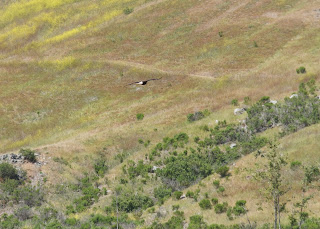The rookery was bustling with activity. Some of the juveniles appeared as large, if not larger than their parents, and like typical teenagers they were constantly begging for food. At first all I saw was a mass of black. Through binoculars, I began to see the nestlings. At birth they are without feathers and sightless. Within a week they are covered with fluffy down. A nestling, needing to eat frequently, often has its bill extended up toward a parent's neck. This action will stimulate the parent to regurgitate. The nestling will feed by inserting its bill into the parent's throat.
I saw more juveniles than little ones because the little ones were tucked away under the adults. Sometimes a tiny head would appear. Tending the young is shared by both parents. Nestlings are dark grey with whiteish speckles, particularly on their wings. (for details click on images)
Can you locate the three juveniles in the center of the above photo?

The nests, glued together with excrement, form a concretion.
Nestlings lower center of above photo.
On a rock face, below the hustle and bustle of the rookery, was a Black-crowned Night Heron and a solitary Brant's Cormorant. It was clear to me that they did not believe in the adage, "Birds of a feather flock together."
Pelagic Cormorants were located one mile north at Sea Lion Cove.
White excrement marks the nest sites; ten were occupied. No little ones could be seen. Compared to the Brandt's, the scene was serene.In about two weeks I am planning on taking another jaunt to Point Lobos. Hopefully, Pelagic chicks will be active. On every visit to the Point Lobos Preserve I have shown my docent, state park pass and entered without having to pay a $9.00 fee.














